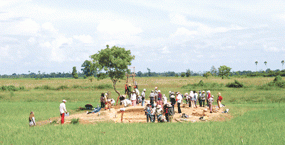Pyu burial site discovered at Sri Ksetra
Cherry Thein
Source - http://www.mmtimes.com/2011/news/601/news60108.html

Excavations at a mound in Pyu city of Sri Ksetra. Pic: Supplied
A burial site has been excavated in Bawbawgyi and Myinbarbu pagodas in the ancient Pyu city of Sri Ksetra in western Bago Region.
Excavation of the site began in September and has been led by the Department of Archeology, National Museum and Library under the Ministry of Culture, with the remains of a brick structure discovered northeast of the Yahannar temple.
Sri Ksetra is located in Hmaw Zar village, about five miles southeast of Pyay. It flourished as a major Pyu settlement from the fourth to ninth centuries AD, pre-dating the rise of Bagan in the 11th century.
The structure remains are 22 metres long, 12 metres wide and 1.5 metres high. A total of 288 pots and burial urns of several sizes have been unearthed. The site is thought to have been three storeys high with a brick exterior wall and a central open area used for cleaning burial urns.
U Kyaw Oo Lwin, director general of the Department of Archaeology, said the excavation aimed to develop understanding of the culture, lifestyle and architecture of Sri Ksetra relative to other Pyu settlements, such as Beikthano, Maingmaw and Hanlin.
“The things we discovered are revealing of the … Pyu civilisation, [including its] culture and customs. We are not sure what else we might find in future but hope to discover more [about the Pyu] from archaeological sites around the country,” he said.
“It is one of the customs of the Pyu civilisation to bury urns under the building, [a practice] which has also been found in other areas influenced by Pyu civilisation.”
Clay tablets of the decorative frontlet of the Buddha and votive tablets were unearthed at the site, which has been confirmed as a cemetery for Pyu Buddhists.
Burial urns encased in earth-plastered pots were designed in nine shapes, including the lotus, circle, wheel and Brahminy duck, which are similar to those found at Tagaung, north of Mandalay.
Various kinds of nails, grub hoes, swords, arrows and mushrooms were also found, together with 868 iron bars, a bronze bell measuring 70 centimetres in diameter, two decorative bronze rings and 17 bronze rings with no decorations.
In 1967-68, the department discovered two other burial sites in Sri Ksetra. However, they were soon damaged because they were not covered and archaeologists lost a chance to learn from those burial sites, said U Kyaw Oo Lwin.
To protect this third site, the department is working to build a museum at the excavation area, he said.
The department has also been co-operating with the United Nations Educational, Science and Cultural Organisation (UNESCO) to achieve recognition the ancient cities of Sri Ksetra, Beikthano and Hanlin as world heritage sites.
“We have submitted to the organisation a brief biography of each city, their cultural value, results from excavations and current situation of sustainability so that the judge can decide [whether] to list them. We have only to complete a final submission to the board,” said U Kyaw Oo Lwin.
“We need to improve archeological excavation, which is beneficial to the country’s heritage. We need to work to protect this heritage at the same time as encouraging and educating people to cherish it,” he added.